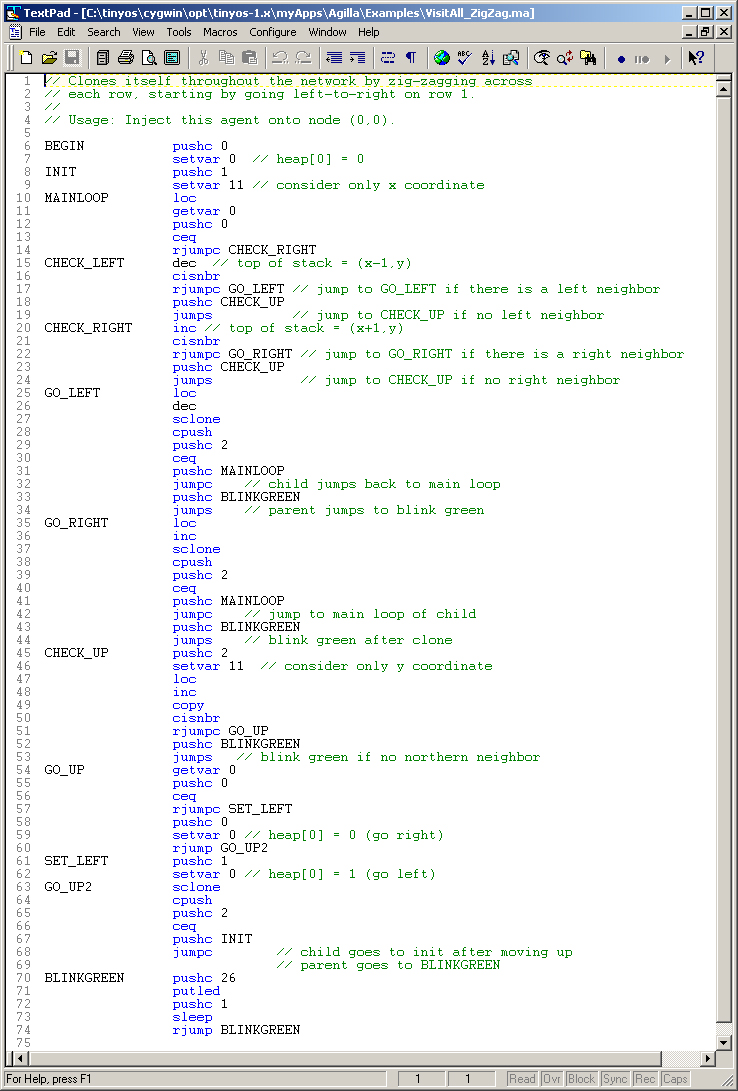
Last Updated on November 3, 2005 4:23 PM .

Agilla allows agents to seamlessly migrate across a multihop network. Since all addressing is done based on location, the agent specifies a location to which it moves or clones. Agilla handles all of the multihop geographic routing. The programmer only needs to specify the destination location and the type of migration. This greatly simplifies programming and enables more efficient programming.
The migration instructions are wmove, smove, wclone, sclone. Note: the term "migration" encompases both "move" and "clone" instructions. The first letter indicates whether the migration will be strong or weak. Strong migrations preserve execution state, weak migrations do not. In other words, when an agent executes a strong migration, its program counter, heap, opstack, and reactions are all transferred to the destination location. When an agent executes a weak migration, only its code is transferred, everything else is reset and the agent resumes executing from the beginning. Move instructions move an agent to another node, while clone instructions produce a copy of the agent on the destination node (both agents continue executing independently afterwards). All migration insructions take a destination location as a parameter.
Consider the example agent Bounce0to1 located in <agilla/Examples/Bounce0to1.ma:

This is an agent that jumps between nodes (0,0) and (1,1). It blinks the red LED once at each node upon arrival. Lines 1-6 blink the red led for a second. Lines 7-9 checks whether the agent is currently at (0,0). On line 10, the agent jumps to GOTO11 if it is currently as (0,0), otherwise, the agent continues executing at line 11. Lines 11-12 and 15-16 perform the migration. In both cases, a wmove is used, meaning an agent resumes executing at the beginning when it arrives at the destination. The instructions immediately following the wmove (on lines 13-14 and 17-18) implement the contingency plan when the wmoves fails and is described below.
After an agent performs an sclone, it is often important for the agents to determine who is the original agent and who is the cloned agent so they can behave in different ways. To support this, Agilla sets the condition code of the original agent to 1, and the clone to 2. The agent can then check this to determine who is the clone. Consider the following agent VisitAll_ZigZag located in <agilla/Examples/VisitAll_ZigZag.ma:

This agent clones itself onto every node in the network by traversing each row in a zig-zag fashion. The agent utilizes sclone because it must remember which direction is is travelling (going left or right along a row). Upon arrival, it clones itself on the next node depending on its direction of travel, and then blinks the green LED. Consider line 27 where the agent performs an sclone. Immediately after this instruction, lines 28-33, display the code that checks whether the the agent is the original or the clone. Here, the original agent jumps to BLINKGREEN, while the clone jumps to MAINLOOP.
Wireless sensor networks utilize radios that are notoriously unreliable. Since agents are migrated using multiple messages, there is a chance that the migration operation will fail. The agent learns about the failure in different ways based on the type of migration: